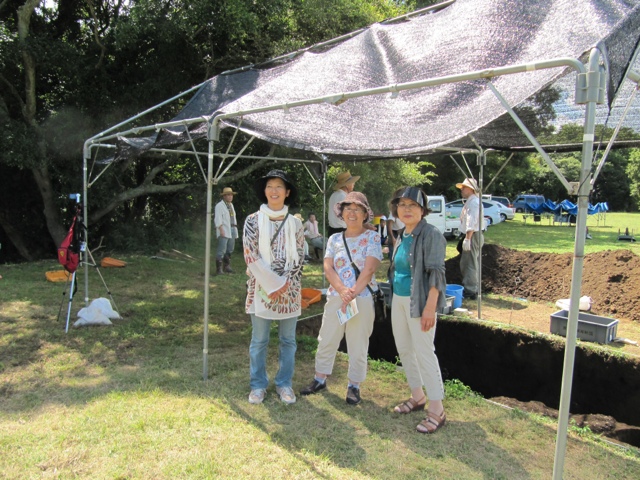On September 9, 2012 we hopped in the car with Shigeko-San and drove to see a Jomon pottery museum near Kasumigaura (lake). We were met at the museum by Shigeko-san's mother who is unusually "genki" or healthy for someone in excess of eighty years. She enlisted the aid of another person in the museum to guide as through the exhibits. The Jomon people are noted for their distinctive pottery much of which as impressions of rope on the surface. The pottery was fired possibly in open fires, but was quite advanced compared to the rest of the world at the time. The pieces being exhibited are in fact reproductions, an art that Shigeko-san's mother is quite adept at. The originals had gone to the University of Tokyo for a special exhibition.
The Jomon people existed as the dominant people in Japan for thousands of years until about two thousand years ago when another group of people migrated here from Asia. These new immigrants brought iron tools and rice culture with them and began the Yayoi era. At some time prior to the Yayoi era a large part of Ibaraki-ken where we live was actually part of the Pacific Ocean. The elevated plateaus such as the one we are living on were dry land and inhabited by the Jomon people.
My understanding is that one of the staple foods of the Jomon was "kuri" or chestnuts. The Okadaira shell mounds demonstrate that the Jomon people in this area ate a lot of shell fish of varying sizes and species as well. The shells were discarded over the edge of the cliffs. Over time these mounds were covered by soil and today are being excavated in an effort to understand more about these people.
Shigeko-san's mother led us on a tour around the grounds to see the dig site and a recreation of a Jomon home. The home was constructed of large timbers and roofed as well as walled with a thick layer of straw. The interior is excavated earth which is mounded around the home to aid in keeping it dry. I suspect that this home is built more intelligently than the Japanese homes of today in the sense that it is probably cooler (and probably just as warm) thanks to large duplicate vents at the peak.
After the tour we drove to a nearby C.C. (country club or golf course) and had curry udon lunch after visiting a Buddhist "tera" or temple nearby. After lunch we went to see Shigeko-san's mother's home where Shigeko-san grew up. From here three of us walked in the hot sunny afternoon to Kasumigaura where children used to swim when Shigeko-san was young. After ice cream sticks to cool off we drove back home, stopping for a few groceries on the way.
Click on Jomon Okadaira Shell Mound to see photographs on Picasa.


No comments:
Post a Comment